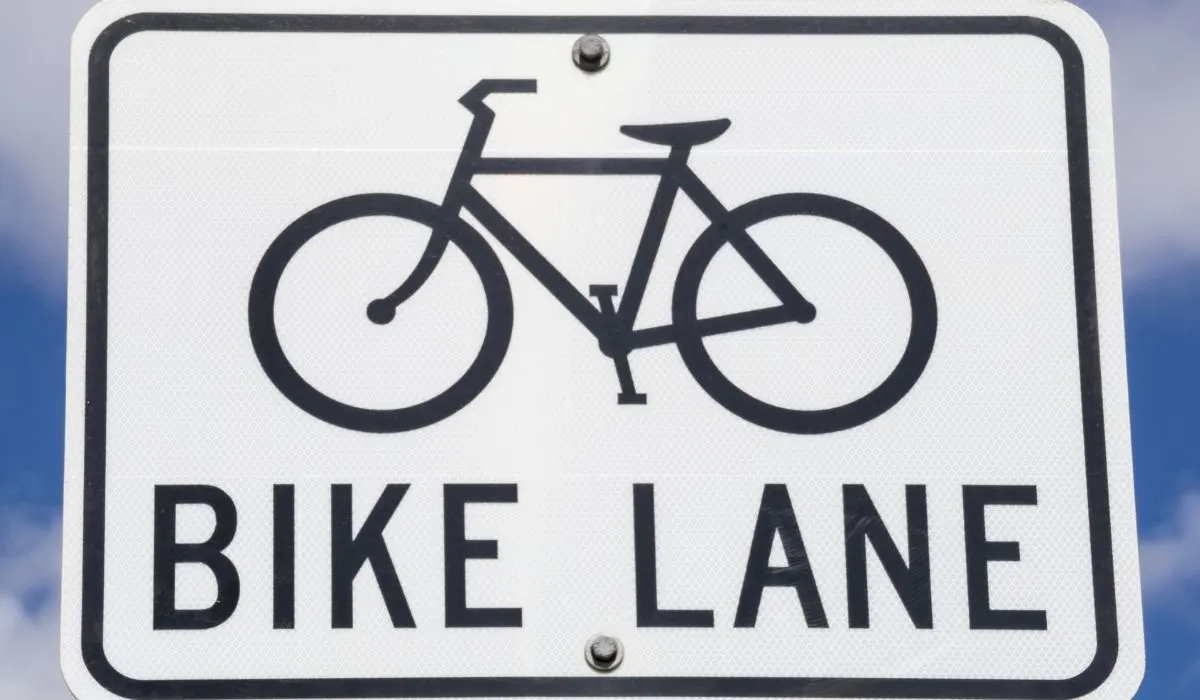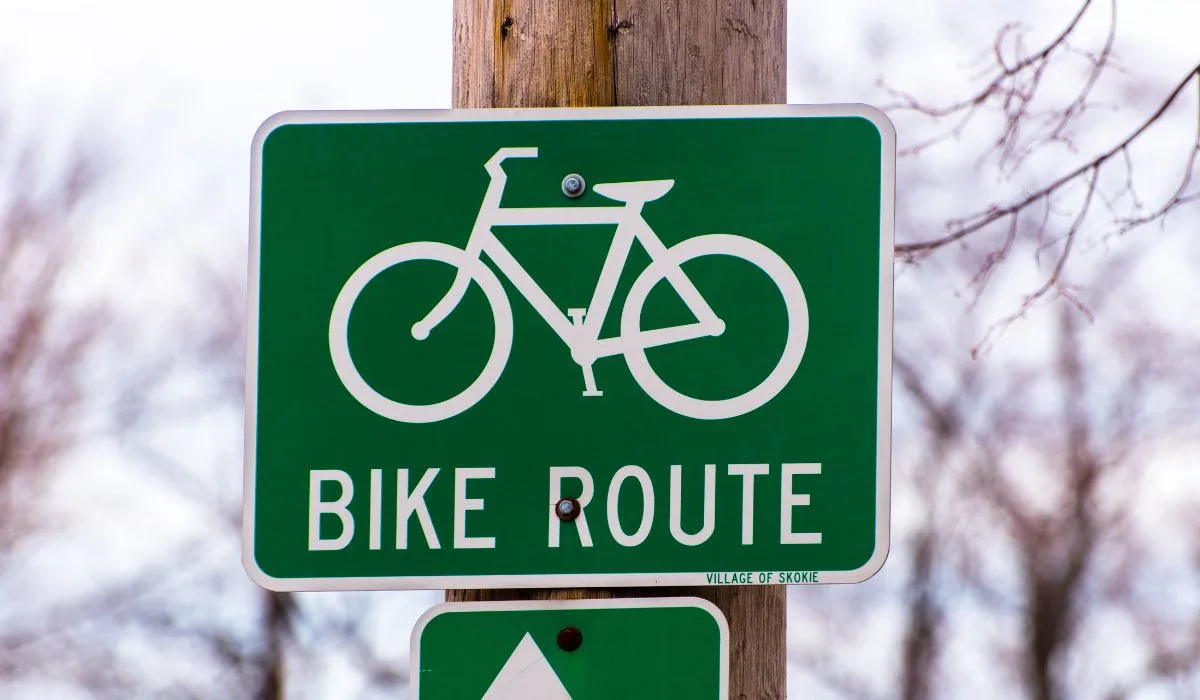
While riding a bicycle on the sidewalk may be perfectly legal in one state, it may be strictly prohibited in another state. For this reason, it’s always a good idea to check the state laws governing bicycle operation on sidewalks!
While biking laws differ in every state, many states allow bicyclists to ride on sidewalks, provided they yield to pedestrians and avoid business districts. In some states, cyclists may also be permitted to audibly signal when passing pedestrians. Other states strictly prohibit sidewalk riding.
While our guide will give you a better understanding of how these biking laws differ between states, it’s important to note that states allow local municipalities to set their own rules. Due to this, it’s always best to verify any local ordinances regarding riding a bike on a sidewalk in your area.
A Full Guide For Riding Bikes On Sidewalks In Each State
From Alabama to Wyoming, we’ll outline the different state laws regarding bicyclists riding their bikes on a sidewalk!
Alabama
In Alabama, bicycles are banned from being driven on sidewalks. Bicycles also may not be driven on the roadway when a designated bike path is available.
Alaska
In Alaska, bicycles are mostly permissible to be driven on sidewalks, so long as cyclists yield the right-of-way to pedestrians. No person may ride on a sidewalk in a business district.
Arizona
No laws prohibit bicyclists from riding on the sidewalks among other pedestrians in the state of Alaska.
Arkansas
Arkansas state laws do not prohibit bicyclists from riding their bikes on sidewalks. However, the state does encourage bicyclists to be mindful of pedestrians.
California
In California, no state laws prohibit cyclists from riding on the sidewalk. However, this may vary between local municipalities.
Colorado
Under Colorado law, people can ride their bicycles on a sidewalk, provided they yield the right-of-way to pedestrians.
Connecticut
In Connecticut, cyclists are allowed to operate on sidewalks and crosswalks provided they yield to the right-of-way of pedestrians and provide audible signals when passing any pedestrians.
Delaware
Delaware laws do not prohibit bicycles from being operated on sidewalks or crosswalks. However, riders must yield to pedestrians and may not ride in any area prohibited by traffic-control devices.
Florida
In Florida, it is perfectly legal for bicyclists to ride their bikes on a sidewalk. However, if the sidewalk is crowded with pedestrians, it may be better for bikes to be ridden on the side of the roadway.

Georgia
In Georgia, it is illegal for anyone over twelve to ride a bike on a sidewalk. However, those aged twelve and under may legally ride their bikes on sidewalks.
Hawaii
In Hawaii, it is illegal to ride bikes on the sidewalk in business districts. In areas where it is legal to ride on the sidewalk, cyclists must yield to any pedestrians and provide audible signals when passing pedestrians. Furthermore, bicyclists may not exceed 10mph when riding on a sidewalk.
Idaho
In Idaho, bicycles are permitted on sidewalks, but cyclists must yield to pedestrians and audibly signal their presence when passing them.
Illinois
While Illinois state laws allow you to ride on the sidewalk, this may be prohibited by some local ordinances.
Indiana
Indiana state laws allow bikes to be operated on sidewalks, but this may be prohibited by local ordinances.
Iowa
While some local municipalities in Iowa prohibit sidewalk biking, there are no official state laws preventing this.

Kansas
Kansas state law does not allow bicycles to be ridden on sidewalks.
Kentucky
In Kentucky, cyclists may operate on sidewalks but must yield to pedestrians and slow down to walking speeds when pedestrians are present.
Louisiana
Louisiana doesn’t have state laws that authorize or prohibit riding bicycles on sidewalks.
Maine
In the state of Maine, bicycles are permitted to be used on sidewalks, provided they yield to pedestrians.
Maryland
Unless allowed by local ordinances, cyclists are not allowed to ride on sidewalks under Maryland state laws.
Massachusetts
In Massachusetts, unless prohibited by local ordinances, bicycles may be operated on sidewalks outside of business districts.
Michigan
In Michigan, bicycles can be operated on sidewalks, provided they yield to the right-of-way of pedestrians and provide audible signals when overtaking pedestrians.
Minnesota
Unless prohibited by local authorities, bicycles may be used on sidewalks in Minnesota.
Mississippi
Mississippi doesn’t have state laws that authorize or prohibit riding bicycles on sidewalks.
Missouri
Unless prevented by local laws, bicycles may be used on sidewalks (excluding downtown areas) in Missouri.

Montana
In Montana, state laws allow bicyclists to ride on sidewalks, provided they yield to any pedestrians.
Nebraska
Nebraska does not have any state laws that prohibit you from riding your bike on a sidewalk.
Nevada
Unless prohibited by local regulations, Nevada state laws allow cyclists to ride on most sidewalks.
New Hampshire
In New Hampshire, riding a bike on a sidewalk is prohibited. Luckily, there are many scenic roadways ideal for cycling!
New Jersey
In New Jersey, there are no statewide laws prohibiting the use of bikes on sidewalks.
New Mexico
New Mexico doesn’t have state laws that authorize or prohibit riding bicycles on sidewalks.
New York
In New York, it is illegal for those older than twelve to ride on sidewalks. Only riders aged twelve and under with wheels that do not exceed 26 inches in diameter may ride on the sidewalk.
North Carolina
Apart from city center areas, bicycles are permitted on sidewalks under North Carolina state laws.
North Dakota
In North Dakota, state laws strictly prohibit the use of bicycles on sidewalks, regardless of what local laws state.
Ohio
In Ohio, cyclists are prohibited from riding their bikes on sidewalks.
Oklahoma
In Oklahoma, except for business districts, cyclists may ride on sidewalks.

Oregon
Unless it is prohibited by local ordinances, sidewalk riding is generally permitted in Oregon.
Pennsylvania
In Pennsylvania, cyclists may only ride on the sidewalk when no bike lane is available. Furthermore, cyclists may not ride on sidewalks in business districts in Pennsylvania.
Rhode Island
Unless prohibited by traffic devices, cyclists in Rhode Island may ride on the sidewalks.
South Carolina
Unless prohibited by local ordinances, cyclists may ride on sidewalks in South Carolina.
South Dakota
Unless prohibited by local municipality laws, cyclists are allowed to ride on sidewalks in South Dakota.
Tennessee
Unless prohibited by local laws, cyclists may ride on sidewalks in Tennessee.
Texas
Under Texas law, bicycles are considered the same as other vehicles. While operating a bike on a sidewalk is prohibited by Texas state laws, this varies according to local ordinances.
Utah
Except for the downtown districts, cyclists may use bikes on sidewalks in Utah.
Vermont
In Vermont, bicycles are allowed on sidewalks. However, cyclists must yield to pedestrians, ride at lower speeds, and stop at driveways and intersections.
Virginia
Unless prevented by local ordinances, bicycles may be operated on sidewalks in Virginia.
Washington
In Washington, you can ride bikes on sidewalks and crosswalks, provided you yield to pedestrians.
West Virginia
In West Virginia, sidewalks are reserved for pedestrians traveling by foot. Cyclists are prohibited from riding on sidewalks.
Wisconsin
In Wisconsin, bicyclists are allowed to ride on sidewalks, provided they yield to pedestrians.

Wyoming
In Wyoming, bikes may not be legally operated on sidewalks or crosswalks.
Conclusion
Although biking laws vary from state to state, many states allow bicyclists to ride on sidewalks, provided they yield to pedestrians and avoid busy downtown areas.
Some states specify that cyclists must audibly signal when passing pedestrians, while others only allow riders below a certain age to ride on the sidewalks. In some states, sidewalk riding is strictly prohibited.
